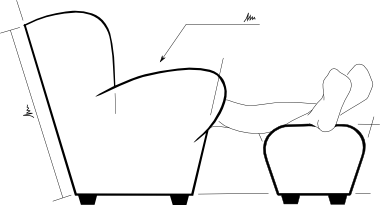Cockpit Clearances
Designing a cockpit to accommodate a range of rider sizes is more complex than laying out the controls to fit one rider; especially having a steering wheel control for such a reclined operator instead of underseat/tiller steering or a moveable yoke.
To account for different height riders while still keeping the rider’s eyeline above the height of the bulkhead, the seat back reclines, pivoting near the hip joint. All of the swept area must be clear of any other objects. Below the body swept area is space usable for luggage, except where the chain passes through.
To cycle, there has to be room for the rider’s legs to move as they pedal, so the swept area of the rider’s thighs has to be kept clear; the rider’s legs mustn’t hit the bulkhead, nor the steering wheel. Position of the steering column is not affected though, as the rider’s legs will pass either side of it.
Having a steering wheel in the cockpit with the rider in such a reclined position presents a trickier packaging requirement then underseat steering. Not only must the wheel be clear in the straight ahead position, it must also not interfere whilst turning, including the protruding brake levers.
As the body area pivots close to the hip position to accommodate different height riders and the wheel has no variation of position, the best position for the wheel is directly above the rider’s hips. Height of the steering column must be set so the wheel doesn’t impact the rider at the bottom and doesn’t hit the screen (with clearance for the rider’s hand) at the top. A lack of steering wheel adjustment means that there will be a variation in hand position depending upon rider height.
The low height of the cockpit area also means that full steering lock (>±90⁰) may bring the bottom of the wheel (and brake lever) close to the rider and the top of the wheel will obscure some of the rider’s forward vision. Though this isn’t too much of a problem, as full steering lock will only be useful at very low speeds (e.g. for parking or turning round) when the speed of reaction for braking is less critical. All normal riding should need much lower steering wheel angles.

